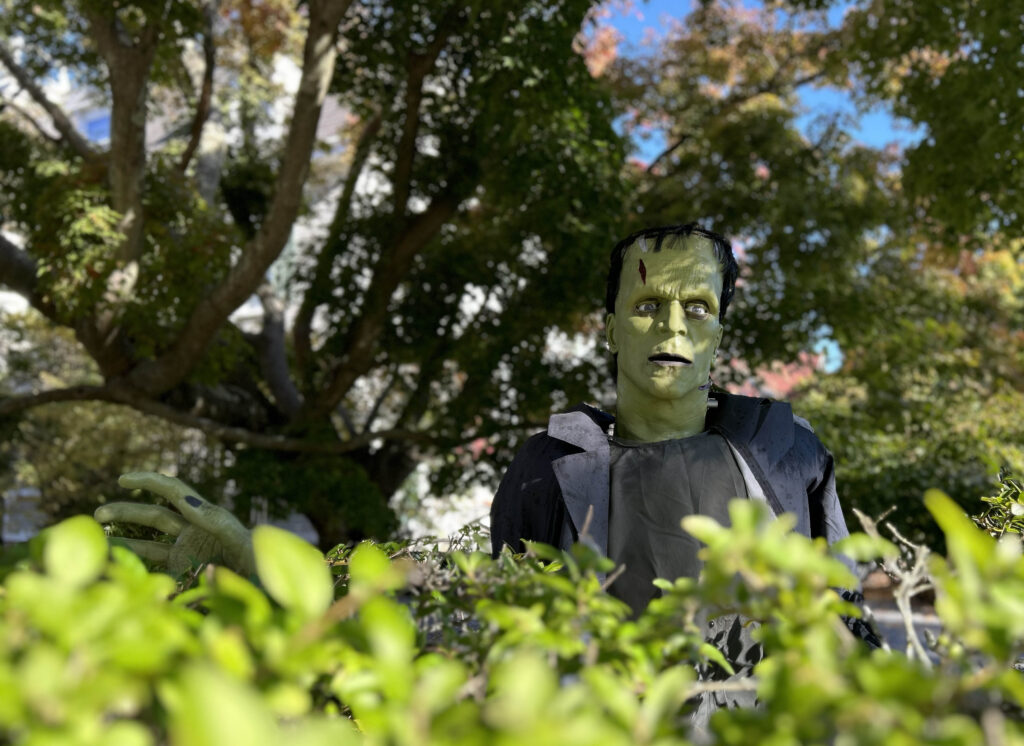
A Frankenstein monster lurks in a shadowy hedge in Newport, Rhode Island. (Janine L. Weisman/Rhode Island Current)
Samhain, my Wiccan friends told me years ago, was the time of year when the veil that sits between the worlds is thinnest. During this time, we can reach out to the other side, speak to the dead and divine the future. It is also the time when the old gods, or other spirits, might walk in our world.
An old European holiday that fell at the deepest moment of the fall, it may originally have been simply a marker of the season. But there are hints at something more interesting and obscure; a focus on forces and entities that we no longer recognize. A history of syncretism with the Catholic Church, and immigration into the United States, has morphed this holiday into Halloween.
A century ago (and a bit longer), Halloween in America was, as it is now, a holiday for children and families. There was mischievous behavior, costumes, and spooky decorations. Going door to door with your neighbors was part of the celebration, as were parties, and bonfires. Many of these elements seem to descend from the ancient traditions, but there was a public encouragement, only slightly effective, to avoid the ghosts and witches and devils that have been central to the event. Still, when I was young, devout Christians of several denominations would not participate in Halloween, as it seemed to celebrate things that were at a minimum, pagan, and at worst demonic.
What have we created for Halloween traditions now?
Well, for starters, we have done the most American of things. We have made it a consumer extravaganza, and a time for adults to behave like children. We now spend about $12 billion on Halloween, a 300% increase since 2005. And over 70% of us celebrate, although most have removed any ritual, or spiritual component to the day.
Our attention to Halloween costumes and parties rivals any other holiday in America, with workplaces and schools decorated and staging events. My grandchildren, a pumpkin and a witch, are attending at least four Halloween parties, including at school, in their town square, and at the offices of each of their parents. My grandnephew has multiple distinct, elaborate, Halloween costumes, including a Jack Skellington assemblage that could appear on stage.
At the same time, adult-size costumes, pet costumes, and yard decorations are on sale in stores that pop up in our communities for this purpose only. Eight-foot skeletons with lighted eyes, witches on brooms, and gravestones draped in spider webs are on display throughout my neighborhood.
The explanation is sometimes offered that this holiday can appeal to everyone equally and without offense, as it is not associated, at least any longer, with any particular religious beliefs. Nor is it attached to the history of colonization like the traditionally Puritan-centered Thanksgiving (which frankly is my favorite holiday if you leave the false history and the Puritans out entirely).
I am going to suggest another reason why we have come to love Halloween, and to celebrate with abandon. It goes back to our beginnings.
There are some things that are so connected to our ancient heritage that they are still in our bones. The hiss of a snake still gets our attention. Most of us fear the cold and the dark. This time of year, as spectacularly beautiful as it is, anticipates the approach of winter, a time when we have had, for the past million years or so, reasons to feel anxious. And I am not at all sure that we have completely walked away from the notion that forces beyond our ken might lurk in the shadows.
Because we are no longer people who are comfortable with obvious communal ritual, we do what we are comfortable with. But I think no matter how much we make Halloween a goofy celebration, with sexy nurses and tiny demons, we are still working hard to push the darkness away. As our ancestors did long ago, we engage in a kind of sympathetic magic, dressing as goblins and ghosts, and gathering together to make light of it all, as a way of convincing ourselves there is nothing to fear.
GET THE MORNING HEADLINES.
Rhode Island Current, like Oregon Capital Chronicle, is part of States Newsroom, a nonprofit news network supported by grants and a coalition of donors as a 501c(3) public charity. Rhode Island Current maintains editorial independence. Contact Editor Janine L. Weisman for questions: info@rhodeislandcurrent.com. Follow Rhode Island Current on Facebook and X.

